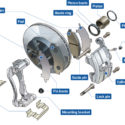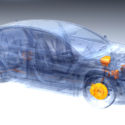The story of the automotive industry has been one of gradual growth, as vehicle technology has steadily progressed over the century history of the industry. Many of the automotive features found in popular commercial models today have their origins in the world of motorsports. Let’s take a closer look at some of the major car technologies with roots in auto racing.
Disc Brakes
In the early days of the automotive industry, drum brakes were the standard choice for braking systems. However, modern braking systems generally use disc brakes. While drum brakes contain all major components inside of a metal drum, disc brakes consist of a small caliper and slim rotor, which work together to stop the wheels.
Disc brakes were introduced in the 1953 24 Hours of Le Mans Grand Prix race. That year, Team Jaguar used three C-type racing cars equipped with cutting-edge (at that time) disc brakes. These brakes helped Jaguar earn first place in the race. Disc brakes were introduced to consumers two years later with the 1955 Citroën DS.
Anti-Lock Braking Systems
Since 2011, anti-lock braking systems have been a legal requirement for automobiles produced in the United States. This technology began in the aviation industry and was originally only used on airplanes. This changed in 1961 when the Ferguson P99 racecar became the first automobile to feature ABS. Today, anti-lock braking systems are primarily used to decrease braking distance.
Carbon Fiber Bodies
Carbon fiber is highly preferred over standard metal auto bodies in the motorsports world, as it is both stronger and lighter. This material allows racecars to move faster with added protection if a collision happens. Racecars were also made of metal until the 1980s, when many Formula One teams made the switch to carbon fiber for a competitive advantage. The material was primarily used in the racing world until recently due to higher costs but has recently been introduced in consumer vehicles.
Push-Button Ignition
Push-button ignitions are starting to become the standard in consumer vehicles, but they have always been the preferred method for starting racecars. The push-button ignition was introduced in racing vehicles to minimize start time for drivers in the pit lane.
Commercial vehicles have a wide range of push-button systems. For example, modern BMW models require the driver to insert a key first to make sure they don’t start the car accidentally. Other automakers use an electronic key fob to communicate with the vehicle, which automatically activates the ignition button when the driver enters the vehicle.
Dual Overhead Camshafts
The camshaft is a key engine piece, which is tasked with opening the valves that let air inside and expel exhaust fumes from the engine. Cams are rotating lobes that press against the valves to open them up, which are then closed by springs on the valves. This process significantly influences the performance of the engine.
Dual overhead camshafts (DOHC) are used in high-performance engines, as they are more powerful and capable of functioning at higher speeds. The vast majority of racing vehicles use dual overhead camshafts for these reasons. The first DOHC was introduced in 1912 by Georges Boillot, who won the French Grand Prix that year. Over a century later, this technology has become widespread in modern consumer vehicles.
Rearview Mirrors
Even some of the most basic car accessories have their roots in motorsports, including rearview mirrors. The first rearview mirror was used during the first Indianapolis 500 race in 1911, when the racer Ray Harroun attached his own mirror to his vehicle to keep an eye on the cars behind him. Before that, racers had a passenger ride with them watch their blind spots. Rear-view mirrors became standard features in commercial vehicles in 1914.
Suspension Systems
Modern suspension systems are descendants of the original racecar suspensions. In the beginning, racecars used two types of suspension systems: multi-link and MacPherson struts. The multi-link suspension debuted in Formula 1 racing and is common in modern off-road vehicles. MacPherson struts, on the other hand, have their roots in NASCAR.
While the suspension systems of consumer vehicles are related to their racecar counterparts, there are some major differences. Naturally, most consumer vehicles do not have the same handling as a racecar. Racecar suspensions are designed to maintain stability when taking high G-force turns and traveling at high speeds. Consumer suspension systems are more focused on a balance between performance and comfort.
All-Wheel Drive
All-wheel drive (AWD) was first introduced by the Audi rally team in their revolutionary 1980 Quattro road and rally car. This model was the first to capitalize on a recent rule change that allowed four-wheel drive to be used in competitive racing. The Quattro would go on to win four world rally championship titles between 1982 and 1984. This technology provides smoother handling in both flat roadways and more difficult terrain and is now a standard feature in the auto industry.









